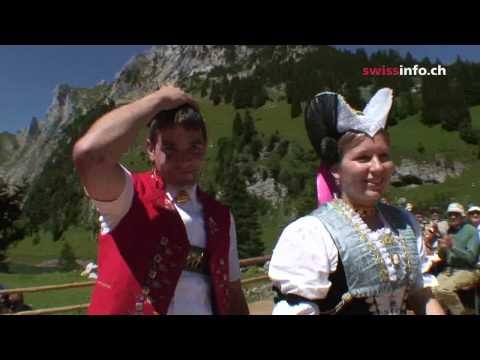Discover The Beauty of Traditional Clothing of Switzerland
Nestled in the heart of Europe, Switzerland boasts of an awe-inspiring landscape, a rich cultural heritage, and a long history of traditional clothing that’s as fascinating as it is diverse. Switzerland is home to different kinds of cultures, ethnic groups, and even climates. This has led to significant variations in traditional Swiss clothing as well as in modern times.
In this article, we’ll take a closer look at the traditional clothing of Switzerland, its history, and its evolution over the years. Whether you’re a fashion enthusiast or a traveler, learn about this exciting journey through Swiss fashion and explore the unique charm of Swiss traditional clothing.

PIN IT FOR LATER…

This post may contain affiliate links. If you buy something through one of those links, you won’t pay any extra penny, but I’ll get a small commission that encourages me to deliver more helpful content for you.
Table of Contents
Traditional Clothing in Switzerland
How do people dress in Switzerland? The traditional costume of the common people in Switzerland, however, remains much more distinct, with variations based on the canton, gender, and occupation of the person.
The female Swiss traditional outfit is very embellished with pretty and traditional accessories. The male folk dress is very simple and ordinary, and in some other parts of the country, it looks rather aristocratic and stylish.

The national costume of Switzerland is multifaceted but made in the same style and design; bright but sober; eccentric but balanced; convenient but enticing.
Traditional Dress of Switzerland for Men
The Swiss men in the Alpine region generally wear the lederhosen, which are basically knee-length pants with suspenders, often made from leather. Lederhosen is flexible, durable, and also helps to climb and hike in the mountains terrain.
Short-sleeved shirts(mainly white), woolen medium knee-socks, and black slip-on shoes are also worn by Swiss men. They also preferred to wear a short-brimmed felt hat in the winter season and a wide-brimmed straw hat in summer. It adds extra beauty and gives completeness to their traditional outfit.

Fun Fact: Bachelors keep a bright red handkerchief hanging from the left pocket of their trousers. It indicates that the man is unmarried. It’s an unusual tradition of men in Switzerland and very convenient for Swiss women who are also single.
Traditional Costume of Switzerland for Women
The traditional attire of Switzerland for women is quite like today’s “dirndl“, which is basically a full skirt and a tight sleeveless top. The top is usually white in color, and the rest of the outfit is finished with colorful decorations and accessories like stockings, buckled black slip-on shoes, and a headpiece or hat. Women often wore aprons around the waist to protect their clothing while working.
Check out the pictures of the traditional clothing of Switzerland below.
When it is about Swiss clothing for women, the color of the clothes is the main factor. They generally like to wear a bright color and the color of their costume indicates the canton, marital status and so on. Women from Obwalden canton wear white color whereas the typical clothing color for Zurich canton is blue.
Even the jewelry is different for different cantons and can be a definition of marital status. In Obwalden, married women wear white bonnets and golden jewelry whereas single women wear silver.
Traditional Dress of Switzerland for Children
Traditional Swiss dress for children is basically a miniature version of the costumes worn by adults, with the differences in color to reflect the gender of the wearer. Boys tend to wear darker colors such as black, blue, and gray, whereas girls prefer to wear red and white.
The traditional dress of Switzerland for children often features elements such as puffed sleeves, colorful aprons, and intricate embroidery. Lederhosen and Dirndls are also popular for young boys and girls respectively, and are typically worn for special occasions and cultural festivals.
Read Next: 8 Incredible Christmas Markets in Switzerland
Tights
Tights are the most convenient, flexible, and easy to carry in traditional Swiss fashion. You can purchase tights from the store while some Swiss families are still continuing their tradition of making hand-knitted tights (selbsgestrickten) especially made for babies.
Only dark-colored tights were worn by Swiss boys and girls preferred to wear bright colors such as red and white until around 1960. Later tights became popular in various other colors and children started to wear bright-colored tights.

Traditional Embroidery
It’s very common among the Swiss to decorate clothing with traditional embroidery. Swiss girls are trained from their childhood and they are experts to stitch on hats, scarves, and shirt cuffs. Embroidery also decorates fabric and usually, the flowers which can be found in the Swiss Alpine are embroidered on clothing.
Smocks
Smocks are another traditional Swiss costume worn by Swiss-Italians and Swiss-French boys and girls. Mainly, smocks were used as school uniforms. The smock is also used in the parade, festive occasions, work, and much more!
Buy Beautiful & Comfortable Smocks
Traditional Clothing in Swiss Festival
Nowadays the Swiss generally wear Western-style clothing, but when it’s time for traditional festivals, they still wear the traditional dress of Switzerland which was worn by their ancestors at parades and festivals.
In an offbeat place in Switzerland known as Gruyere, cattle herders at most festivals can be seen sporting a short red canvas jacket over a half-sleeved shirt and black trousers. The women wear silk aprons, long-sleeved jackets, and straw hats with ribbons hanging from the brim. Gruyere is also known for making delicious Swiss cheese.
Other traditional women’s clothing includes gold lace caps in St. Gallen and dresses with golden and silver ornaments in Unterwalden. The male wears a short leather dress which is called lederhosen in the Swiss Alpine area. Slip-on leather shoes are common for both males and females.

Interesting Facts on Traditional Costume of Switzerland
- Most cantons or regions of Switzerland maintain different dressing style for Sunday (Sonntagstracht) and weekdays (Werktagstrachten).
- Male traditional Sunday outfit which is also called the “Sunday best outfit” is embellished with jewelry, embroidery, buckles, and chains, etc. They often wear neckerchiefs and fine accessories such as pocket watches, canes, trimmed belts, and similar implements.
- Women’s “Sunday best outfits” are highlighted with floral embroidery which is nothing but needlework on hats, scarves, and shirt cuffs. Swiss women are trained in needlework and they embellish their costumes with embroidery.
- The popular motifs are edelweiss flowers, mountains, and cows with cowbells. Although every canton has its own themes and heroes, like animals, shepherds, flowers, mountains, people in national dress.

Note: While embroidery used to be a popular home industry in the eastern and northeastern regions of Switzerland, but unfortunately it’s now limited to tourism because the Swiss people no longer dress in traditional Swiss clothing. However, The Swiss attires are significant in terms of their versatility and vividness along with their lively motifs and embroidery.
FAQs:
1. What occasions are traditional Swiss clothes typically worn for?
A: Traditional Swiss clothes are typically worn for special events and festivals such as weddings, folk festivals, and other cultural celebrations.
2. How does traditional Swiss clothing differ from region to region?
A: Traditional Swiss clothing differs from region to region in terms of style, fabric, and design, with each area having its own unique and distinct costumes that reflect their local culture and heritage.
3. What are some notable features of Swiss traditional clothing?
A: Notable features of Swiss traditional clothing include vibrant colors, intricate embroidery, and the use of high-quality fabrics such as wool, linen, and silk. The garments are often adorned with decorative elements such as buttons, belts, and hats.
LIKE IT? PIN IT…

READ NEXT:









Is there anywhere I could buy a Swiss girl’s dress (age 12-18 months)? Many thanks for your help.
Hi Elisabeth, thank you for showing your interest in the Swiss dress. You can check Amazon or Etsy to find a Swiss girl’s dress. Search ‘swiss girl costume’ at Etsy, there you will find many options.
What I love about traditional attires is their relation to nature. Those motifs including edelweiss flowers, mountains, and cows with cowbells define the folk culture of the place. I am definitely going to wear it someday.
Yes, the traditional dresses are always beautiful.
My great aunt traveled in Austria, Switzerland and Germany in the 30s (I believe) and brought home a traditional dress for my mother who was still a young girl. While looking through the family cedar chest today I found a most remarkable costume. It is heavily beaded with a bird crest (falcon I believe). Beautiful embroidery. Many pieces…skirt, bodice, headband, thinner fabric of petticoat, blouse, a square embroidered whatever. Can you help me identify it if I send photos? What should I do with an antique European costume? I’m getting old and need to downsize.
Hi Robin, I would love to see those photos. You can send it at [email protected]. I will recommend to keep these antique costumes to yourself. These are always priceless and your future generation would love to see these definitely.